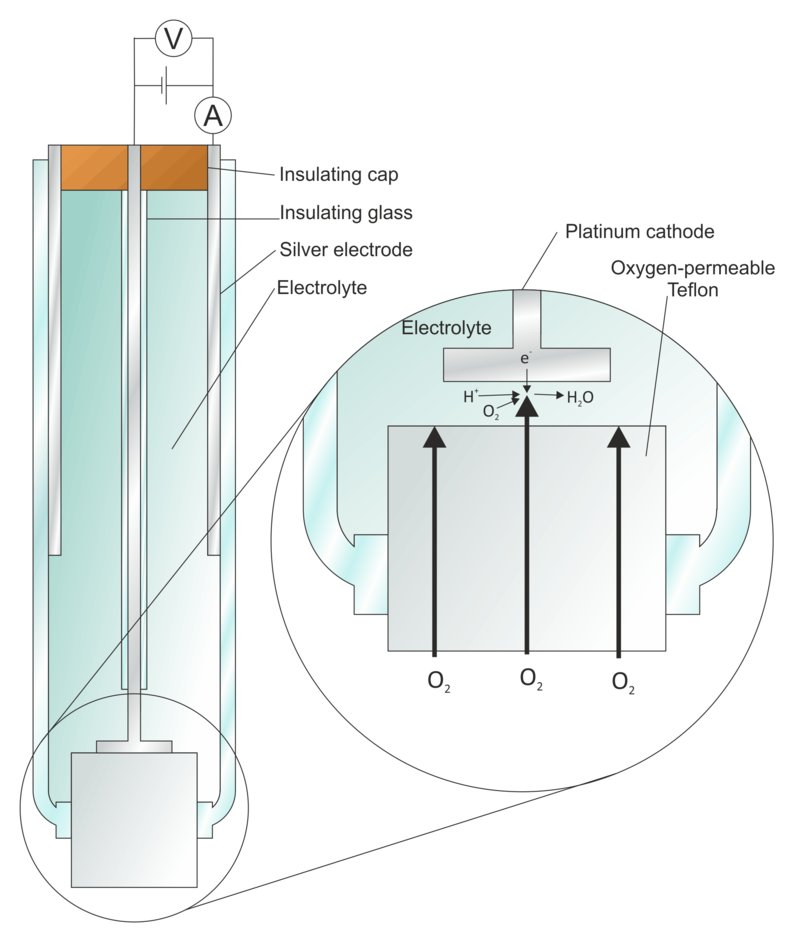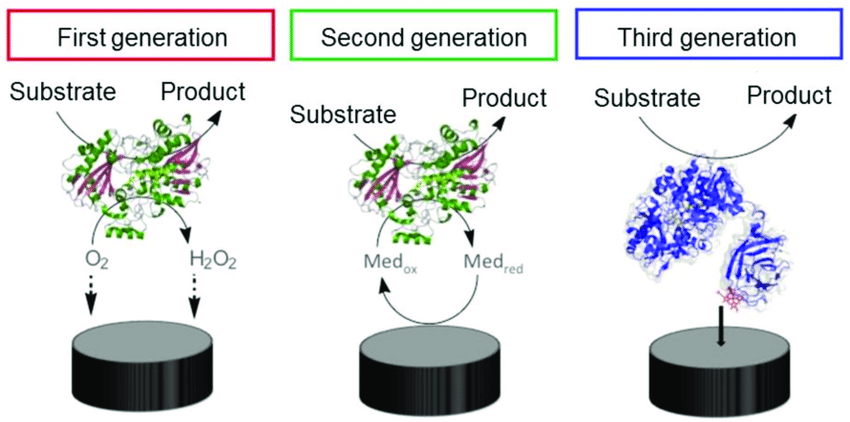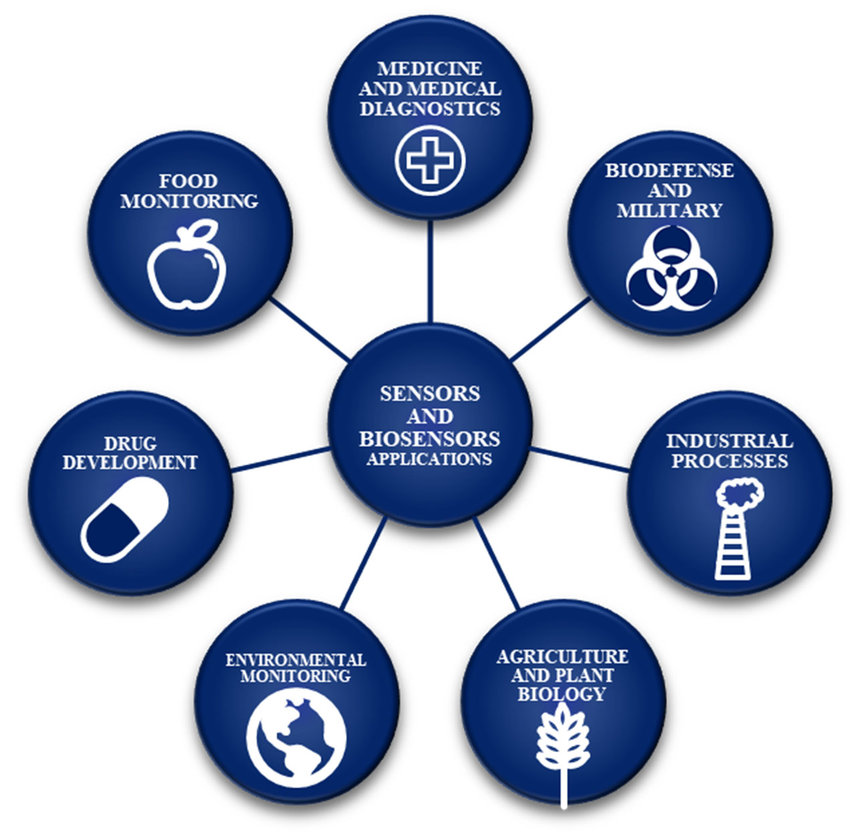Have you ever wondered how your smartwatch tracks your heart rate or how VR suit responds to your physical actions? The secret lies within a tiny, yet powerful device called biosensor. From the world of healthcare to immersive virtual reality experiences, biosensors are making a significant impact, and today, we’re going to unpack this revolution.
Let’s take a look at the history of biosensors, explore possible applications and consider the future of biosensors.
General Definition
At their core, biosensors are ingenious devices that bridge the gap between biological and digital realms. Biosensor is an analytical device used for the detection of a chemical substance that combines a biological component with a physicochemical detector.

It consists of a biological element, such as an enzyme, nucleic acid, or antibody, which interacts with a specific analyte of interest, triggering a unique biological response. This response is then converted into a measurable signal, enabling us to obtain valuable data and insights. This remarkable fusion of biology and technology enables to capture and interpret vital physiological data in real-time.
History of Biosensors

The inception of biosensors can be traced back to the late 1950s, when American biochemist L.L. Clark invented the first biosensor, known as Clark electrode. The Clark electrode is a small chamber filled with a special solution containing molecules that are sensitive to oxygen. When the electrode is placed in contact with a sample of blood, the oxygen in the blood reacts with the molecules in the electrolyte solution. This interaction causes a change in the electrical properties of the solution. To get the data, two more electrodes detect and measure the electrical signal.
A schematic representation of Clark’s invention, the Oxygen Electrode (Source: Wikipedia)
Historically, biosensors can be divided into three generations.
1st Generation:
The first generation of biosensors is like the early pioneers. These biosensors measure the concentration of certain substances or the products of chemical reactions. They do this by allowing those substances to reach a special detector, which then generates an electrical response. It’s like detecting the presence of something by looking at how it affects electricity.
2nd Generation:
The second generation of biosensors is like an improved version of the first. They involve using mediators, which are like helpers or messengers, to enhance the response of the biosensor. These mediators make the biosensor more sensitive and accurate in detecting the substances of interest. It’s like having someone who assists you in getting more precise information.
3rd Generation:
The third generation of biosensors is the most advanced and efficient. In this generation, biosensors no longer need mediators. Instead, the biological response itself triggers the detector directly. It’s like having a direct line of communication between the substance being detected and the biosensor. This eliminates the need for extra steps and simplifies the process, making the biosensor more reliable and responsive.

Taken together, these three generations represent the progress and improvements made in biosensor technology over time. Each generation is built on the previous one, refining the capabilities of biosensors and expanding their applications in fields ranging from healthcare to environmental monitoring and beyond. Currently, most new product R&D is focused on second- and third-generation biosensors, as they become more efficient at delivering results.
Application areas
Now miniaturised into portable devices, biosensors deliver stability, low cost, high sensitivity and reproducibility. Therefore, the development of intelligent devices will gradually increase, enabling rapid growth in the dynamic realms of virtual reality and healthcare.
Biosensors have significantly impacted various industries, but their journey is far from over. As technology advances and our understanding of biology deepens, the future of biosensors holds immense promise. Here are some of the exciting developments that are on the horizon.

Miniaturization and wearable integration
We can see how biosensors are becoming more compact and wearable, seamlessly integrating into our lives as smartwatches and other products. This trend will lead to a proliferation of biosensors, empowering individuals to monitor their health and well-being effortlessly.
Multi-Modal and Multi-Analyte Detection
The future of biosensors lies in their ability to detect multiple analytes simultaneously, providing a comprehensive and holistic view of our health. By integrating various sensing modalities, such as optical, electrical and chemical sensors, biosensors will unlock new possibilities for diagnosing complex diseases and monitoring multifaceted biological processes. This multi-analyte approach will offer a deeper understanding of our bodies and enable personalized interventions.
Artificial Intelligence and Data Analytics
Biosensors generate vast amounts of data, and harnessing this information effectively is crucial. Artificial intelligence (AI) and machine learning algorithms will be pivotal in extracting valuable insights from biosensor data. These advanced analytics will enable early disease detection, personalized treatment recommendations, as well as the identification of patterns and trends that were previously inaccessible. Combining biosensors and AI will revolutionize healthcare and empower individuals to take proactive control of their well-being.
Biosensors in Environmental Monitoring
Biosensors will continue to play a crucial role in environmental monitoring, enabling us to assess and mitigate the impact of pollutants, contaminants and climate change. These sensors can detect toxins, heavy metals and microbial impurities in air, water and soil, helping us protect ecosystems, ensure food safety and preserve our environment for future generations.
Bioelectronics and Cyborg Technologies
The convergence of biosensors with electronics and prosthetics opens up the realm of cyborg technologies. We can restore or enhance human capabilities by integrating biosensors with artificial organs, implants, and prosthetic devices. For example, biosensors integrated with neural interfaces could enable precise control of prosthetic limbs or facilitate brain-computer interfaces, revolutionizing the lives of individuals with physical disabilities. Additionally, worth to mention how biosensors can enhance the VR experience and provide interesting healthcare data.
Advantages of using biosensors for VR and Healthcare industries
Personalized Biometric Feedback and Enhanced Immersion: Through real-time monitoring, biosensors can provide users with valuable insights into their own physiological responses during virtual experiences. This personalised feedback opens up new avenues for self-improvement, stress management and performance optimisation. It also creates a heightened sense of presence as the virtual environment reacts in sync with the user’s physical responses, enhancing overall immersion and realism.
Health and Wellness Monitoring: The capabilities of biosensors go beyond entertainment and gaming. This real-time data can be used to detect anomalies, monitor stress levels and provide valuable insights into overall well-being. The integration of biosensors into the healthcare environment will make it possible to remotely monitor patients, track progress and intervene when necessary.
Advancing Research and Development: The integration of biosensors provides researchers and developers with a powerful tool for advancing the fields of AR/VR and human-computer interaction. By collecting comprehensive biometric data during virtual experiences, researchers can gain valuable insights into human behaviour, cognitive responses and emotional states. This data can drive innovations in adaptive content creation, user experience design and personalized interventions.
The future of biosensors is bright and full of possibilities. With ongoing advancements in technology and a growing emphasis on personalized medicine, biosensors will empower individuals, revolutionize diagnostics and treatment, and pave the way for a healthier and more connected world.
